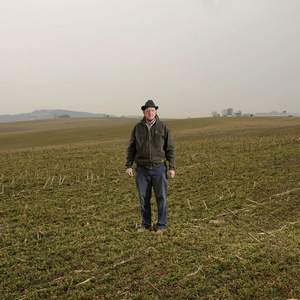Farmers in parts of Virginia are turning more and more to no-till practices to reduce labor and even increase yields.
"I'll never go back to tilling," said third-generation dairy farmer Junior Beachy of Staunton, who grows corn, soybeans, small grains, hay and alfalfa for his 400 cattle on 500 acres of rolling, shale-bed farmland near the mouth of Christians Creek. "There's fields on this farm that every time you tilled you'd just have to plan on going back and picking up a whole bunch of rocks. Well, that's history for me."
The decision to give no-till farming a try in 2004 was an easy one for Beachy when, after consecutive years of low yields, he took a farmer up on an offer to see his no-till fields in Dayton.
"What he had in his fields was what I wanted in my fields," Beachy said. "We were struggling. We'd come through some drought years, some pretty low yields. We just weren't quite cutting it, and I was looking for something better."
Beachy had a record yield of 200 bushels of corn an acre just two years after switching.
"I want to farm this land for the rest of my life, and I want my kids to be able to farm this land too," said Anthony Beery, a dairy and poultry farmer with 400 acres in Mount Crawford whose family has been farming as far back as he knows, at least four generations. "Well, there isn't going to be anything to farm on if I'm losing my topsoil every year."
Despite increased fertilization since World War II, the organic matter content of U.S. soil has steadily decreased, said soil scientist Dr. Joel Gruver of Western Illinois University, and the primary culprit has been erosion.
"When you think about topsoil that's the most important soil. That's where the organic matter is," said Virginia Cooperative Extension agent Matt Yancey. "If you lose that you're basically losing a lot of productivity."
Beery, who gave up conventional tilling in 2004, used to have so much topsoil run off his property during heavy rains that he would collect it from the street and dump it back onto his property. Today, he's retaining his soil and nutrients like phosphorous and nitrogen that his crops rely on, and that local waterways are getting too much of.
"It's good for me, it's good for the people downstream, and ultimately it's good for the Chesapeake Bay," he said.

|
|
Junior Beachy uses no-till techniques to farm his land near Stuarts Draft, Va. Beachy stands in a cornfield covered with alfalfa. (News Leader photo) |
Beachy, who has his soil tested every two years by an agronomist, has seen the organic matter in his soil go from an average of 2.45% in 2007 to more than 4% in 2011.
It's not just loss of erosion either that makes the soil more rich. The soil itself becomes more productive when untilled.
Tilling kills earthworms and literally turns bacteria types on their head. Conventional tilling sends aerobic bacteria, which need oxygen, below the surface, effectively suffocating them, and brings anaerobic bacteria to the surface, effectively poisoning them. Undisturbed, these microbes decompose organic matter into nutrients for crops.
"There's a huge time savings," said Yancey, adding that an Cooperative Extension survey in 2010 showed 55% of central Shenandoah Valley farmers were already practicing no-till or conservation-tillage farming. "You can be doing something else besides altering, basically destroying, that soil structure."
"It's a lot of money and labor savings," Beery said. "With fuel prices what they are, we are seeing quite a bit of savings per acre."
"The time and labor savings are very important. There's no way me and my son could farm this many acres if we were still doing tillage," Beachy said. "I know it works here. You've got to kind of change your mentality about your soil and how you're handling it. It helps to at least have some idea what is happening in your soil. This has been a learning process for me, but what I have found is that (no-till practices) provide the ideal setting for Mother Nature to do her work."






Post a comment
Report Abusive Comment